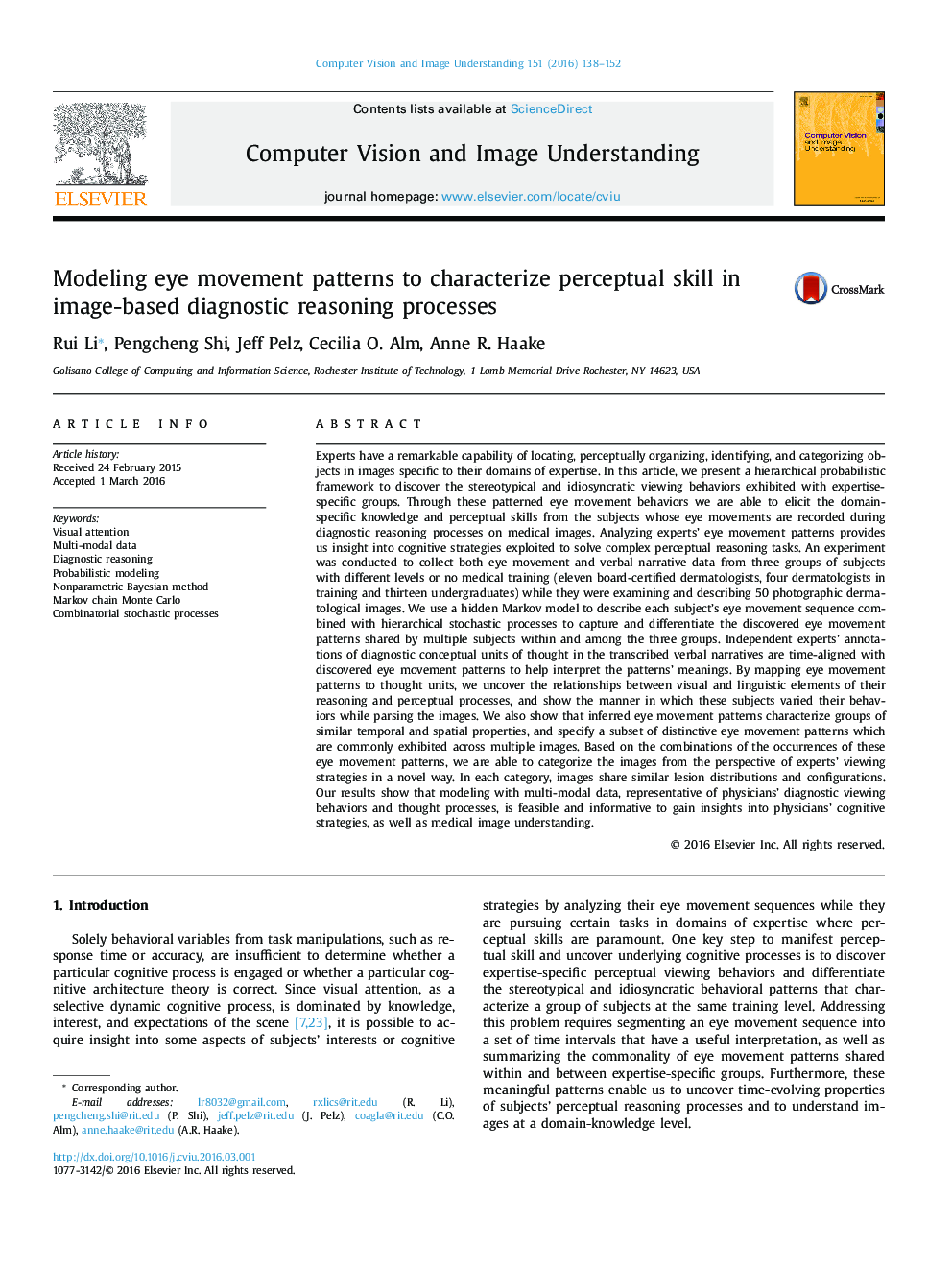| کد مقاله | کد نشریه | سال انتشار | مقاله انگلیسی | نسخه تمام متن |
|---|---|---|---|---|
| 4968897 | 1449751 | 2016 | 15 صفحه PDF | دانلود رایگان |
عنوان انگلیسی مقاله ISI
Modeling eye movement patterns to characterize perceptual skill in image-based diagnostic reasoning processes
ترجمه فارسی عنوان
مدل سازی الگوهای حرکت چشم جهت توصیف مهارت ادراکی در فرایندهای استدلال تشخیص مبتنی بر تصویر
دانلود مقاله + سفارش ترجمه
دانلود مقاله ISI انگلیسی
رایگان برای ایرانیان
کلمات کلیدی
توجه ویژهای، داده های چند مدال، استدلال تشخیصی، مدل سازی احتمالی، روش بی پارسی غیر رسمی، زنجیره مارکوف مونت کارلو، فرایندهای تصادفی ترکیبی
ترجمه چکیده
کارشناسان قابلیت قابل توجهی دارند که مکان، سازگاری، شناسایی و دسته بندی اشیاء را در تصاویر خاص به حوزه های تخصص خود دارند. در این مقاله، یک چارچوب احتمالی سلسله مراتبی را برای کشف رفتارهای دید کلی و خصوصی که در گروه های خاص تخصص وجود دارد، ارائه می کنیم. با استفاده از این رفتارهای رفتار حرکتی الگوی ما می توانیم دانش و مهارت های ادراکی خاصی را از افرادی که حرکات چشم در فرآیندهای استدلال تشخیصی در تصاویر پزشکی ثبت شده اند، استخراج کنیم. تجزیه و تحلیل الگوهای حرکتی چشم کارشناسان، بینش ما را به استراتژیهای شناختی که برای حل وظایف استدلال پیچیده ادراکی استفاده می شود، مورد استفاده قرار می دهد. یک آزمایش برای جمع آوری هر دو حرکت چشم و داده های روایی کلامی از سه گروه از افراد با سطوح مختلف و یا بدون آموزش پزشکی (11 پوستر گواهی پوست، 4 متخصص پوست در آموزش و 13 کارآموز) انجام شد، در حالیکه آنها 50 تصویر درماتولوژی عکاسی را بررسی و توصیف کردند . ما از یک مدل مارکف پنهان برای توصیف دنباله حرکت چشم هر موضوع همراه با فرآیندهای تصادفی سلسله مراتبی برای ترسیم و تشخیص الگوهای تشخیص چشمی کشف شده توسط مشترکین چندگانه داخل و بین این سه گروه استفاده می کنیم. حاشیه نویسی کارشناسان مستقل از واحدهای مفهومی تشریحی تفکر در روایت های رونویسی کلامی با زمان بندی الگوهای کشف شده چشم به منظور تفسیر معانی الگوها هماهنگ است. با نقشه برداری از الگوهای حرکات چشم به واحدهای تفکر، روابط بین عناصر بصری و زبانی استدلال و فرایندهای ادراکی را کشف می کنیم و شیوه ای را که در آن این رفتارها در حین تجزیه تصویر ها تغییر می کند، نشان می دهد. ما همچنین نشان می دهیم که الگوهای حرکتی چشم، گروه های ویژگی های زمانی و مکانی مشابه را مشخص می کنند و یک زیرمجموعه از الگوهای حرکات چشم مشخص را که معمولا در چندین عکس نمایش داده می شوند، مشخص می کند. بر اساس ترکیبی از وقایع این الگوهای حرکت چشم، ما قادر به دسته بندی تصاویر از منظر استراتژی های مشاهده کارشناسان به روش جدید است. در هر رده، تصاویر تقسیمات و تنظیمات ضایعات مشابه توزیع می شوند. نتایج ما نشان می دهد که مدل سازی با داده های چند مدال، نماینده رفتارهای تشخیصی پزشکان و فرایندهای تفکر، امکان پذیر و آموزنده است تا بینش های راهبردهای شناختی پزشکان و همچنین درک تصویر تصویری را به دست آورد.
موضوعات مرتبط
مهندسی و علوم پایه
مهندسی کامپیوتر
چشم انداز کامپیوتر و تشخیص الگو
چکیده انگلیسی
Experts have a remarkable capability of locating, perceptually organizing, identifying, and categorizing objects in images specific to their domains of expertise. In this article, we present a hierarchical probabilistic framework to discover the stereotypical and idiosyncratic viewing behaviors exhibited with expertise-specific groups. Through these patterned eye movement behaviors we are able to elicit the domain-specific knowledge and perceptual skills from the subjects whose eye movements are recorded during diagnostic reasoning processes on medical images. Analyzing experts' eye movement patterns provides us insight into cognitive strategies exploited to solve complex perceptual reasoning tasks. An experiment was conducted to collect both eye movement and verbal narrative data from three groups of subjects with different levels or no medical training (eleven board-certified dermatologists, four dermatologists in training and thirteen undergraduates) while they were examining and describing 50 photographic dermatological images. We use a hidden Markov model to describe each subject's eye movement sequence combined with hierarchical stochastic processes to capture and differentiate the discovered eye movement patterns shared by multiple subjects within and among the three groups. Independent experts' annotations of diagnostic conceptual units of thought in the transcribed verbal narratives are time-aligned with discovered eye movement patterns to help interpret the patterns' meanings. By mapping eye movement patterns to thought units, we uncover the relationships between visual and linguistic elements of their reasoning and perceptual processes, and show the manner in which these subjects varied their behaviors while parsing the images. We also show that inferred eye movement patterns characterize groups of similar temporal and spatial properties, and specify a subset of distinctive eye movement patterns which are commonly exhibited across multiple images. Based on the combinations of the occurrences of these eye movement patterns, we are able to categorize the images from the perspective of experts' viewing strategies in a novel way. In each category, images share similar lesion distributions and configurations. Our results show that modeling with multi-modal data, representative of physicians' diagnostic viewing behaviors and thought processes, is feasible and informative to gain insights into physicians' cognitive strategies, as well as medical image understanding.
ناشر
Database: Elsevier - ScienceDirect (ساینس دایرکت)
Journal: Computer Vision and Image Understanding - Volume 151, October 2016, Pages 138-152
Journal: Computer Vision and Image Understanding - Volume 151, October 2016, Pages 138-152
نویسندگان
Rui Li, Pengcheng Shi, Jeff Pelz, Cecilia O. Alm, Anne R. Haake,
